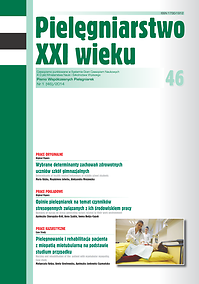Pielęgnowanie i rehabilitacja pacjenta z miopatią miotubularną na podstawie studium przypadku
Słowa kluczowe:
miopatia, studium przypadku, dzieckoAbstrakt
PIELĘGNOWANIE I REHABILITACJA PACJENTA Z MIOPATIĄ MIOTUBULARNĄ NA PODSTAWIE STUDIUM PRZYPADKU
Wprowadzenie. Miopatia miotubularna jest chorobą genetyczną, powodującą osłabienie i zanik mięśni co całkowicie upośledza funkcjonowanie organizmu z zaburzeniem funkcji układu oddechowego włącznie. Chorzy wymagają całkowitej opieki ze strony rodziny, gdyż sami nie są w stanie samodzielnie egzystować. Dzięki programowi długoterminowej opieki domowej nad dziećmi z przewlekłą niewydolnością oddechową, rodziny korzystając z fachowej wykwalifikowanej pomocy medycznej i odpowiedniego sprzętu, mogą w miarę normalnie funkcjonować przenosząc cały proces leczenia do swoich domów. Dzięki temu dzieci mogą przebywać w domu, wśród najbliższych, gdzie nie towarzyszy im ciągły lek, niepokój i szpitalny strach. Natomiast rodzice mogą w miarę możliwości poukładać swoje sprawy. Najważniejsze jest by zapewnić jak najlepszy komfort fizyczny i psychiczny rodzinie, w tym poczucie bezpieczeństwa.
Cel pracy. Celem pracy było poznanie i objęcie zindywidualizowanym procesem pielęgnowania dziecka z choroba genetyczną, którą jest miopatia miotubularna z respiratoterapią domową i ograniczoną sprawnością ruchową w warunkach domowych.
Materiał i metoda. W pracy zastosowano metodę indywidualnego przypadku. Jako narzędzia badawcze wykorzystano: wywiad, obserwację, analizę dokumentacji, dokonano pomiarów: akcja serca, saturacja , ciśnienie krwi.
Wnioski. Dziecko z chorobą genetyczną mięśni, z niewydolnością oddechową, całkowicie zależne od opiekunów. Wymaga zaspokojenia potrzeb w każdej sferze życia fizycznego i psychicznego. Żyje własnym rytmem, we własnym świecie, wyznaczając rytm rodzicom. Rodzice także potrzebują wsparcia, zwłaszcza psychologicznego i niejednokrotnie finansowego, by móc sprostać dużym potrzebom, jakie niesie ze sobą opieka nad nieuleczalnie chorym dzieckiem.
Bibliografia
1. http:// choroby-zdrowie.pl/miesnie/miopatia.html1#ixzz2Q4yKxFiO
2. Szkulmowski Z. Wentylacja nieinwazyjna, wskazania i ograniczenia stosowania w warunkach oddziału intensywnej terapii. Anest Inten Terap 2001; 33: 261-5.
3. Kochański A. Choroby kręgu Charcot-Marie-Tooth – wczoraj, dziś i jutro. Neurol Neurochirur Pol 2006 40, 4: 327-335.
4. Grochmal–Bach B, Knobloch-Gala A. Kryzysy rozwojowe wieku dziecięco młodzieżowego a możliwości społecznego wsparcia. Kraków: Oficyna wydawnicza „Impuls’’; 2005.
5. Gierowski JK, Bętkowska-Korpała B. Psychologia lekarska w leczeniu chorych somatycznie. Kraków: Wydawnictwo Uniwersytetu Jagiellońskiego; 2007.
Pobrania
Opublikowane
Numer
Dział
Licencja
Prawa autorskie (c) 2014 Małgorzata Kołpa, Aneta Grochowska, Agnieszka Jankowicz-Szymańska (Autor)

Utwór dostępny jest na licencji Creative Commons Uznanie autorstwa 4.0 Międzynarodowe.




